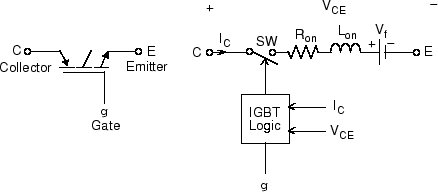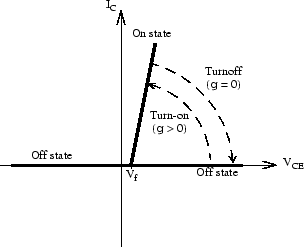このページの内容は最新ではありません。最新版の英語を参照するには、ここをクリックします。
IGBT
絶縁ゲート バイポーラ トランジスタ (IGBT) を実装する
ライブラリ:
Simscape /
Electrical /
Specialized Power Systems /
Power Electronics
説明
IGBT ブロックは、ゲート信号によって制御可能な半導体デバイスを実装します。IGBT は、論理信号 (g > 0 または g = 0) によって制御されるスイッチと直列に接続されている一連の抵抗 Ron、インダクタ Lon、および DC 電圧源 Vf の組み合わせとしてシミュレートされます。

IGBT は、コレクター-エミッター電圧が正で Vf より大きく、ゲート入力に正の信号が印加されている (g > 0) 場合にオンになります。コレクター-エミッター電圧が正でゲート入力に 0 信号が印加されている (g = 0) 場合にオフになります。
コレクター-エミッター電圧が負の場合、IGBT デバイスはオフ状態です。なお、多くの商用 IGBT には逆阻止機能はありません。したがって、通常は逆向きに接続されたダイオードとともに使用されます。
IGBT ブロックには、IGBT デバイスと並列に接続された直列 Rs-Cs スナバ回路が含まれています (端子 A と端子 E の間)。

IGBT モデルのターンオフ特性は、2 つのセグメントで近似されます。ゲート信号が 0 に低下すると、コレクター電流が立ち下がり時間 (Tf) に Imax から 0.1 Imax に低下し、その後テイル時間 (Tt) に 0.1 Imax から 0 に低下します。

例
power_igbtconv の例では、昇圧 DC-DC コンバーターでの IGBT ブロックの使用が示されています。IGBT は、周波数 10 kHz でオンおよびオフが切り替わり、DC 電源から負荷 (RC) にエネルギーを伝送します。平均出力電圧 (VR) は、以下のように IGBT スイッチのデューティ比 (α) の関数です。
仮定と制限
IGBT ブロックは、実際の IGBT デバイスのマクロ モデルを実装します。デバイスの形状も、複雑な物理プロセスも考慮されません [1]。
インダクタンス Lon の値に応じて、IGBT は電流源 (Lon > 0) または可変トポロジ回路 (Lon = 0) としてモデル化されます。IGBT ブロックは、スナバ回路が使用されていない限り、インダクタ、電流源、あるいは開回路と直列に接続することはできません。
回路を離散化する場合、インダクタンス Lon は強制的に 0 となります。
端子
入力
出力
保存
パラメーター
参照
[1] Mohan, N., T.M. Undeland, and W.P. Robbins, Power Electronics: Converters, Applications, and Design, John Wiley & Sons, Inc., New York, 1995.
拡張機能
バージョン履歴
R2006a より前に導入
参考
GTO | Mosfet | Three-Level Bridge | Thyristor